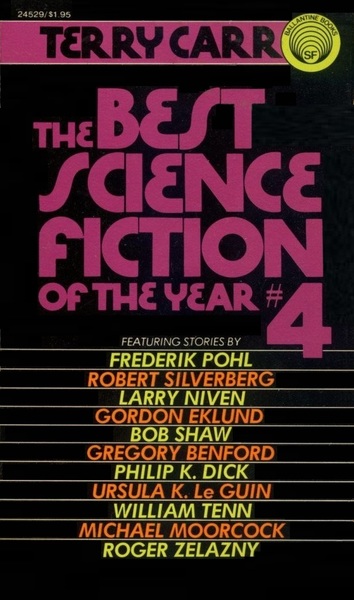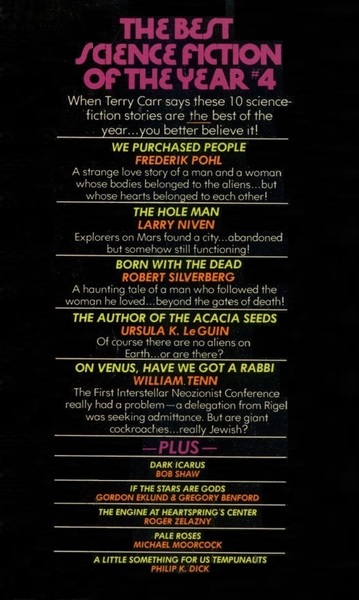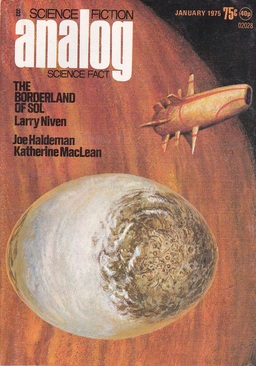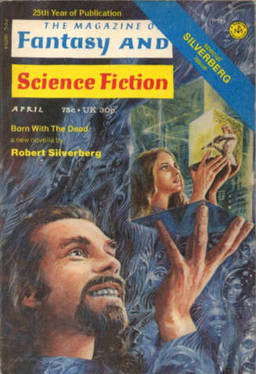Vintage Treasures: The Best Science Fiction of the Year #4, edited by Terry Carr
 |
 |
With all the Best of the Year volumes arriving over the past few months — from Jonathan Strahan, Rich Horton, Neil Clarke, and David Afsharirad, and more due next month from Gardner Dozois, Paula Guran, and others — it’s hard to remember those dark years in the mid-20th Century when there were only two or three.
Hard, but not impossible. Don Wollheim, Lester del Rey, and the great Terry Carr all had Best of the Year anthologies back in the mid-70s. I know because I bought and cherished them as they showed up in bookstores, starting around 1977 or so. I think my favorite editor of the batch was Terry Carr, who was already famous for his exemplary work at Ace at the time.
How good was Carr at extracting the cream of the crop from the digest magazines in the 70s? Depends who you ask of course, but in general Carr’s reputation was stellar. I’d read plenty of anthologies from the era, but I didn’t remember the magazines I read at the time well enough to say for certain.
However, I recently had the opportunity to do a little primary research of my own. I bought a collection of vintage Analog magazines from the early 70s, back when Ben Bova was editor, and I’ve spent a week of warm evenings on the porch with them, pretending I was Rich Horton.
 I’ve been dipping into them more or less at random, reading Larry Niven’s “The Borderland of Sol” (from the January 1975 issue, left), Roger Zelazny’s “The Engine at Heartspring’s Center,” Orson Scott Card’s “Follower” (the first Card story I ever remember reading), and a few others.
I’ve been dipping into them more or less at random, reading Larry Niven’s “The Borderland of Sol” (from the January 1975 issue, left), Roger Zelazny’s “The Engine at Heartspring’s Center,” Orson Scott Card’s “Follower” (the first Card story I ever remember reading), and a few others.
How do they stack up?
I expected to be blanketed in the warm glow of nostalgia, but it’s been pretty rough going, to be honest. Mostly I just end up dissatisfied and occasionally annoyed. Clearly I’ve been spoiled by the level of writing in today’s genre magazines like Clarkesworld, Asimov’s, and Lightspeed, because far too many of these tales are simply a labor to get through. Apparently science fiction has come a long way in four decades.
The winner of the bunch was the Zelazny, although the Card wasn’t too bad. Even the Niven tale — which won the Hugo Award in 1976 — I found choppy, predictable, and just a little too preoccupied with the cool science at its core to really shine as a story. But at least John Schoenherr’s cover art is still great (click the image at left to embiggen).
So how did Carr do with essentially the same material? Let’s have a look at The Year’s Best Science Fiction #4, published in 1975.
I won’t pretend I read with anywhere near the thoroughness Carr clearly did. For one thing, he only picked one story from Analog, the Zelazny (the only one that would have made the cut by my assessment, too), which was nominated for a Nebula. The rest of the book he filled chiefly with tales from anthologies (Final Stage, Wandering Stars, and his own Fellowship of the Stars and Universe 4), rounding it out with one story each from F&SF, New Worlds, and Science Fiction Monthly. Seems like anthologies were the place to go for good writing in the 1970s.
To fill his Table of Contents Carr chose established talents like Frederik Pohl, Michael Moorcock, and Philip K. Dick; future stars like Ursula K. Le Guin; and made a virtual sweep of the stories that would win the major awards that year — including Robert Silverberg’s Hugo-nominated and Nebula Award-winning novella “Born With the Dead,” Niven’s “The Hole Man” (Hugo winner for Best Short Story), and Gordon Eklund and Gregory Benford’s “If the Stars Are Gods,” winner of the 1975 Nebula Award for Best Novelette.
That’s a damned impressive success rate. In an era when science fiction was still shaking off its pulp-era fascination with gosh-wow tales of science, Terry Carr had a keen appreciation for the subtler arts of fine prose, character, and especially originality of idea and execution. The stories in The Best Science Fiction of the Year #4 have aged far better than their contemporaries.
 Here’s the complete Table of Contents.
Here’s the complete Table of Contents.
Introduction by Terry Carr
“We Purchased People” by Frederik Pohl (Final Stage: The Ultimate Science Fiction Anthology, 1974)
“Pale Roses” by Michael Moorcock (New Worlds 7, December 1974)
“The Hole Man” by Larry Niven (Analog, January 1974)
“Born with the Dead” by Robert Silverberg (The Magazine of Fantasy and Science Fiction, April 1974)
“The Author of the Acacia Seeds and Other Extracts from the Journal of the Association of Therolinguistics” by Ursula K. Le Guin (Fellowship of the Stars, November 1974)
“Dark Icarus” by Bob Shaw (Science Fiction Monthly, April 1974)
“A Little Something for Us Tempunauts” by Philip K. Dick (Final Stage: The Ultimate Science Fiction Anthology, 1974)
“On Venus, Have We Got a Rabbi” by William Tenn (Wandering Stars: An Anthology of Jewish Fantasy and Science Fiction, January 1974)
“The Engine at Heartspring’s Center” by Roger Zelazny (Analog, July 1974)
“If the Stars Are Gods” by Gordon Eklund and Gregory Benford (Universe 4, March 1974)
Honorable Mentions
The Science Fiction Year by Charles N. Brown
Carr produced sixteen volumes of The Best Science Fiction of the Year between 1972-1987, before his death in 1987, the last three titled Terry Carr’s Best Science Fiction of the Year (and the final one, Terry Carr’s Best Science Fiction and Fantasy of the Year). He also briefly experimented with novellas, publishing two volumes of The Best Science Fiction Novellas of the Year in 1979 and 1980, a book I still miss.
The Best Science Fiction of the Year #4 was published as a paperback original by Ballantine Books in July 1975. It is 304 pages, priced at $1.95.
See all of our recent Vintage Treasures here.
I read that Le Guin story in one of her collections when I was in my teens. I remember being blown away by the strangeness of it.
I wonder if Tenn’s the author of a piece I read in Analog or Asimov’s in the mid 80’s in which a group of rabbis gather at the invitation of a nervous, slightly embarrassed genetic engineering firm who hope they’ve produced a variation on the pig that can be ruled kosher.
I have the impression of the 1970s as being a time for anthologies like Universe, or Orbit edited by Damon Knight, or Robert Silverberg’s New Dimensions. I looked forward to new issues as eagerly as the “Best of” volumes of today.
Ms. Avery,
With a bit of searching, I found that the story you are recalling is “The R-Strain” by Harry Turtledove (still writing under his initial pen name of Eric Iverson), which appeared in the July 1985 issue of Analog. The ‘R’ stands for “ruminant”, meaning a genetically engineered pig that chews its cud, provoking the rabbinical question.
To nitpick a bit, John, Carr chose two stories from Analog — “The Hole Man” also appeared there. That year — 1974 — was the first year I bought SF magazines, beginning with the August issue of Analog, so I missed both Niven’s and Zelazny’s stories. I may have first read them in Carr’s book, which I certainly bought!
One more nitpick — surely Le Guin was already a major star by 1974, with THE LEFT HAND OF DARKNESS a few years in the past by then.
Well. the 1970s were the busiest decade for BOTY till the most recent two…Harlan Ellison reviewed five sf annuals for a column in F&SF (May 1974), for example: The Wollheim, the Carr, the Del Rey, the Harrison/Aldiss and the Ackerman…and by 1974, there was also an established US YEAR’S BEST HORROR STORIES at DAW, to soon be joined by Lin Carter’s YEAR’S FINEST FANTASY and then Carr’s YEAR’S FINEST FANTASY (which would become the FANTASY ANNUAL as it moved from Berkley to Pocket) and a final volume of the British series which had sparked the US HORROR series, from a new publisher in the UK, and not reprinted here (as Gerald W. Page became the new editor of the DAW annual). Of course, 1974 was the most populous year for sf annuals till recently (not even counting the Nebula volumes) but just barely. The more eclectic annuals in the ’70s were still a bit reluctant, more than now, to include sf so labeled (fantasy as always, was a bit more OK, particularly if not too much a saga), but folks such Joanna Russ had stories in O. HENRY and Thomas Disch could have a fine story, “The Man Who Had No Idea,” in both F&SF and the UK eclectic original anthology series WINTER’S TALES in 1978, alongside Shirley Hazard and V.S. Pritchett stories in the antho voume (and alongside the first, absolutely terrible Gunslinger story in the F&SF). And while a lot of good fiction was appearing in the original anthologies, a lot of good fiction was still in the magazines, and a fair amount of just-acceptably mediocre work was found in both.
Ah, my error…the Lin Carter/Athur Saha annual at DAW was THE YEAR’S BEST FANTASY STORIES…
Ben Bova produced a much livelier ANALOG than Campbell had been driven to do since the name change (or than Schmidt would offer), but it still wasn’t the first stop among fantastic-fiction magazines for good prose…which was still the strongest selling point of F&SF, and at least as likely in FANTASTIC or GALAXY in those years. A story or so from ANALOG would be reprinted in SHORT STORY INTERNATIONAL, my favorite of the eclectic fiction magazines in the late ’70s, in part because I hadn’t yet found new issues of THE PARIS REVIEW or some of their other peers…
Gah. Too early for me to be typing…though I suspect the spell-checker “got” me with Shirley Hazzard’s name above…”such as Joanna Russ” missing its as is all my fault, however.
FINAL STAGE, it should be noted, was a project taken on by F&SF editor Edward Ferman and Barry Malzberg, briefly the previous editor of FANTASTIC and AMAZING, to offer the Ultimate Word in various sorts of sf stories (the Asimov story was run first in F&SF, as a mutually-beneficial promotion)…an impressive anthology that would’ve worked even better if the insane publisher’s editor at the minor publisher Charterhouse hadn’t been allowed to express her contempt for sf by “creatively” going beyond copy-editing to rewrite passages in several stories in the first US hardcover edition. Definitely a case where you want the paperback reprint, instead.
> surely Le Guin was already a major star by 1974, with THE LEFT HAND OF DARKNESS a few years in the past by then.
Rich,
You’re right, of course. That was sloppy…. but also, I suppose, a reflection of my own opinion at the time. I viewed Pohl,, Moorcock, and Dick as established, and Le Guin, Eklund and Benford as newcomers. Rather unfair, since Le Guin had been writing at least as long as Zelazny by then, but I didn’t really discover her until the 80s.
> Harlan Ellison reviewed five sf annuals for a column in F&SF (May 1974), for example: The Wollheim, the Carr, the Del Rey, the Harrison/Aldiss and the Ackerman…
Todd,
Thanks for the tip! It may be worth hunting that down. Back in February I did a piece on Tom Disch’s review of three BEST OF THE YEAR volumes from F&SF and 1979, and it was a lot of fun:
https://www.blackgate.com/2016/02/10/thomas-m-disch-on-the-best-science-fiction-of-1979/
Of course, I only did that because F&SF reprinted the column on their website and I could snip quotes from it with ease….
> by 1974, there was also an established US YEAR’S BEST HORROR STORIES at DAW, to soon be joined by Lin Carter’s
> YEAR’S FINEST FANTASY and then Carr’s YEAR’S FINEST FANTASY…
I was debating mentioning Carr’s fantasy series in this article, but I figured I’d crammed it full of enough publishing trivia already.
> Of course, 1974 was the most populous year for sf annuals till recently (not even counting the Nebula volumes) but just barely.
I hadn’t realized that. I really need to do a more thorough survey of the decade at some point (If Rich doesn’t beat me to it…)
For that matter, I should write one, as I’ve been doing so piecemeal on my blog for a while. It was, another self-correction on this day with too little sleep overnight, 1973 that saw the 1970s record five BOTY meant to be sf volumes…a quaint figure, as we currently stare down the barrel of at least seven in English this year, including two, Rich’s, Paula Guran’s and Jonathan Strahan’s, which intentionally gather sf and fantasy.
Or even three, including Paula’s, as I failed to correct after checking to see there was an announced 2016 Guran. Clearly, time for a nap.
Sometimes, and reading this and the posts on current BOTY offerings, along with the collected years worth of Clarkesworld, Lightspeed, etc, I’m struck by the thought that a person could read nothing but short stories and some novellas and never get around to a novel. It’s the same with mystery genre.
My favorite BOTY from the 1970s was Frederik Pohl’s turn at the Ace version, Best Science Fiction for 1972, which included his own wonderfully surreal “The Gold at the Starbow’s End”. Somewhere, my copy is hiding among the boxes, somewhere. (I hope.)
> For that matter, I should write one, as I’ve been doing so piecemeal on my blog for a while.
Todd,
Clearly I should be reading your blog! And I expect plenty of our readers would be interested as well. Can you share the URL?
Also, if you ever complete that survey, we’d love to see it!
> a person could read nothing but short stories and some novellas and never get around to a novel.
R.K,
Absolutely true! For many years as a teen, after I discovered SF magazines, I was primarily a short fiction reader (I eventually switched to novels).
These days I think it would be even easier, with all the free and easily accessible online fiction.
> My favorite BOTY from the 1970s was Frederik Pohl’s turn at the Ace version, Best Science Fiction for 1972
Eugene,
Thanks for the rec! You mean this one?
I have not read it, but I probably should!
John,
Yes, that is the one, right down to its lovely, loopy cover illo.
I remember that one too, complete with Pohl’s explanation as to why he used one of his own stories: first, he overshot the budget, and he was the only writer he felt like asking to take less money for a story (that, he said, was a “True” reason). But the “Real” reason was that he damn well thought “The Gold at the Starbow’s End” was a great story that deserved its place.
(I agree with him.)
Today’s entry on my blog, SWEET FREEDOM:http://socialistjazz.blogspot.com/2016/07/fridays-forgotten-books-links-to.html
Thanks Todd (and damn! That’s a lot of great links!)